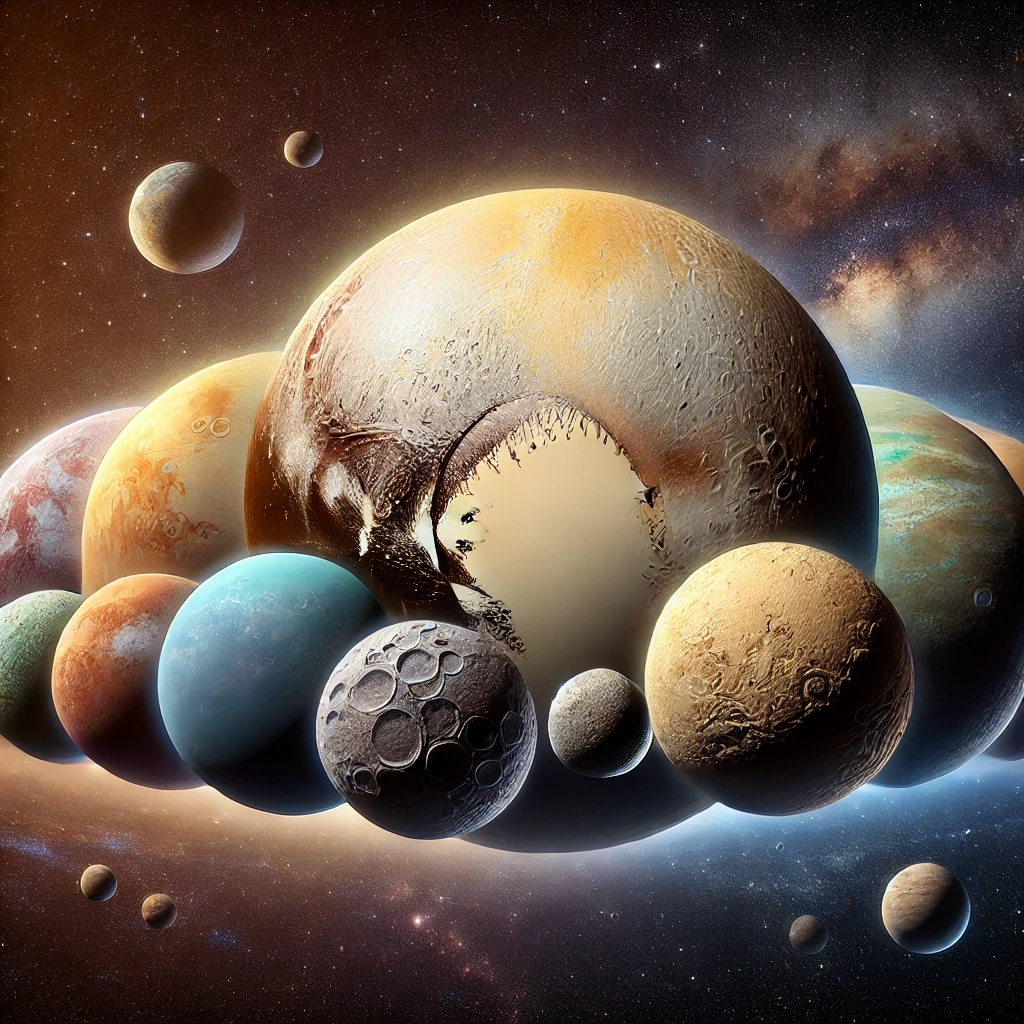Greetings, spacefarers! Captain Nova here, reporting from the Odyssey Explorer on Day 20 of our “100 Days of Space Exploration” journey. Today, we set our sights on some of the most intriguing celestial bodies in our Solar System—dwarf planets. These mysterious worlds challenge our understanding of planetary science and offer fascinating glimpses into the history and evolution of our cosmic neighborhood.
So, strap in and prepare for an adventure beyond the eight major planets, as we journey into the realm of the dwarf planets!

What Are Dwarf Planets?
Dwarf planets occupy a unique category of celestial objects. In 2006, the International Astronomical Union (IAU) officially defined a dwarf planet as a body that:
- Orbits the Sun.
- Has sufficient mass to assume a nearly round shape.
- Has not cleared its orbit of other debris.
This last criterion is what distinguishes dwarf planets from the eight primary planets. Unlike Jupiter, Earth, or Mars, which have gravitationally dominated their surroundings, dwarf planets share their orbits with other small celestial bodies.
The Five Official Dwarf Planets
As of today, astronomers have identified five officially recognized dwarf planets in our Solar System: Pluto, Eris, Haumea, Makemake, and Ceres. Let’s take a closer look at each of these fascinating worlds.
Pluto: The King of Dwarf Planets
Once considered the ninth planet, Pluto was reclassified as a dwarf planet in 2006, sparking much debate and controversy. However, Pluto remains one of the most well-known and beloved celestial objects in our Solar System.
- Distance from the Sun: About 39.5 AU (astronomical units)
- Diameter: 2,377 km (1,477 miles)
- Surface Composition: Primarily nitrogen, methane, and carbon monoxide ice
- Moons: 5 (including Charon, its largest companion)
NASA’s New Horizons mission, which flew past Pluto in 2015, revealed a stunningly diverse and dynamic world. It has vast plains of frozen nitrogen, towering ice mountains, and even evidence of potential subsurface oceans. Pluto’s atmosphere, though thin, consists mostly of nitrogen with traces of methane, creating a delicate blue haze around the planet.
Eris: The Most Massive Dwarf Planet
Eris is often called Pluto’s “twin” due to its similar size and icy composition. However, it is more massive than Pluto and resides in the distant reaches of the Solar System, in a region known as the scattered disk.
- Distance from the Sun: About 96 AU
- Diameter: 2,326 km (1,445 miles)
- Surface Composition: Frozen methane and nitrogen
- Moon: 1 (Dysnomia)
Eris played a key role in Pluto’s reclassification. When it was discovered in 2005, its size and mass raised questions about what defines a planet. This led to the IAU’s decision to create the dwarf planet category.
Haumea: The Fast-Spinning Oddball
Haumea stands out due to its unusual shape and rapid rotation. Unlike the nearly spherical Pluto and Eris, Haumea is highly elongated, likely due to its incredibly fast spin—it completes a full rotation in just under four hours!
- Distance from the Sun: About 43 AU
- Diameter: 1,632 km (1,014 miles)
- Surface Composition: Mostly water ice
- Moons: 2 (Hi’iaka and Namaka)
Haumea is also notable for having a ring system, making it the only known dwarf planet with such a feature. This ring may have formed from debris created by a massive collision in its past.
Makemake: The Cold and Mysterious World
Makemake, named after a deity from Easter Island mythology, is one of the brightest objects in the Kuiper Belt, reflecting a significant amount of sunlight due to its icy surface.
- Distance from the Sun: About 45 AU
- Diameter: 1,434 km (891 miles)
- Surface Composition: Methane, ethane, and nitrogen ice
- Moon: 1 (S/2015 (136472) 1, informally called MK2)
One of the biggest mysteries of Makemake is its lack of a significant atmosphere. Despite similarities to Pluto, Makemake does not appear to have the same kind of extended atmosphere.
Ceres: The Only Dwarf Planet in the Asteroid Belt
Unlike the other dwarf planets, which reside in the Kuiper Belt beyond Neptune, Ceres is found much closer to home, within the asteroid belt between Mars and Jupiter.
- Distance from the Sun: About 2.8 AU
- Diameter: 946 km (587 miles)
- Surface Composition: Water ice, hydrated minerals, and salt deposits
- Moons: None
NASA’s Dawn mission explored Ceres up close, revealing bright salt deposits on its surface, likely remnants of briny water that once existed beneath its crust. Some scientists believe Ceres may still harbor liquid water deep underground, making it a potential candidate for hosting microbial life.
The Future of Dwarf Planet Exploration
Our understanding of dwarf planets is still evolving, and new discoveries continue to reshape our knowledge. Several other celestial bodies—such as Sedna, Orcus, and Quaoar—may one day join the ranks of officially recognized dwarf planets. Future space missions, like NASA’s proposed Interstellar Probe, may help us unlock more of their secrets.
Why Dwarf Planets Matter
Dwarf planets offer valuable clues about the formation and history of our Solar System. Many of them are remnants from the early days of planetary formation, preserving conditions that existed billions of years ago. Studying them helps us understand the building blocks that shaped the planets and moons we see today.
Looking Ahead
Tomorrow, we leave behind the dwarf planets and set our sights on the vast expanse of the universe, exploring how stars and galaxies form. The cosmos is a grand, ever-expanding frontier, and each new discovery brings us closer to understanding our place in it.
Until then, keep your eyes on the stars and your curiosity alive!
Captain Nova
Odyssey Explorer
Leave a Reply